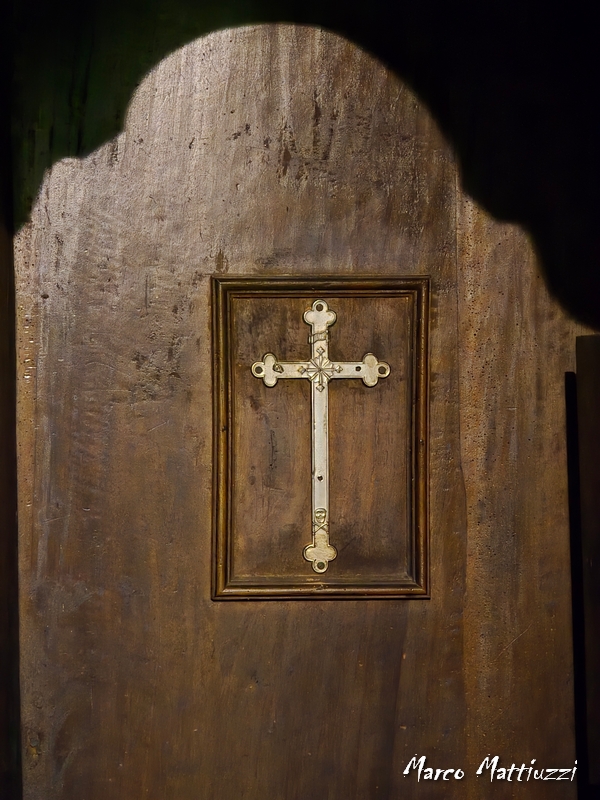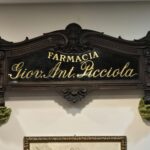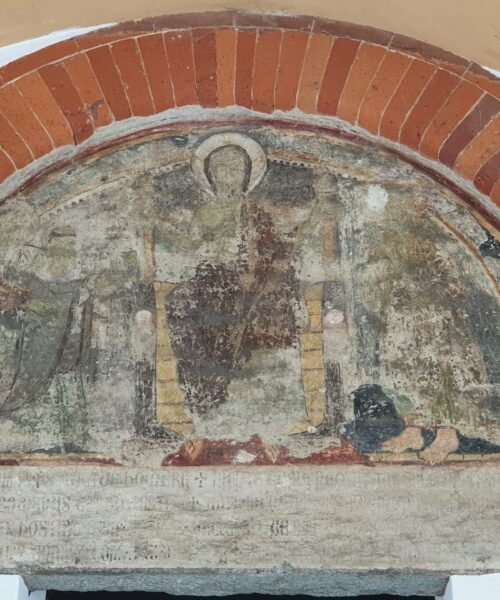As I made my way to an appointment at the “Parlamentino” located in Palazzo Pasta, I found myself with some time to spare and decided to visit the nearby Church of Santa Maria Maggiore, drawn by its history and the promise of revealing centuries-old secrets through its architecture. Upon entering, I was greeted by the unmistakable scent of ancient stone, a mix of dampness and incense that enveloped me like an invisible cloak.
My gaze was immediately drawn to the holy water font at the entrance. Its surface was smooth, polished by the countless hands of devotees who, over the centuries, had dipped into the blessed water seeking divine protection. But today, not far from it, I noticed a modern hand sanitizer dispenser. The presence of this white plastic object struck me deeply: once, holy water was believed to ward off all evil; today, we rely on science and its preventive measures. This contrast prompted profound reflection on the nature of faith and modernity, on how ancient sacredness has been juxtaposed with cold contemporary practicality.

Continuing my walk, I encountered a golden crucifix set within a dark wooden confessional. The light filtering through the stained glass created shadows that danced on the wood, as if narrating tales of whispered prayers and hopes. The contrast between the shining gold of the crucifix and the time-worn wood evoked a sense of majesty and humility, a dualism inviting reflection on the fragility and greatness of human existence.

I looked up towards the altar and was struck by the beauty of the celestial decorations. The sculpted angels seemed ready to take flight, supported by an aura of divine light represented by golden rays emanating in all directions. There was something profoundly reassuring in this vision: it felt as though these ethereal figures were lifting my spirit, reminding me of a higher power that transcends the materiality of the place.

I continued my exploration and stopped before the monumental organ, with its imposing, gleaming pipes reaching upwards like pathways to infinity. I imagined the heavenly melodies that once echoed within these walls, filling the hearts of the faithful with hope and devotion. The intricacy of the carved details in the surrounding wood spoke of skilled and devoted hands, of an art that becomes a prayer, and I lost myself in admiration of such craftsmanship.

Another detail caught my attention: the faux side windows with their painted curtains. These draped paintings seemed to hide more than they revealed, evoking stories of whispered secrets and confessed and absolved sins. Each knot in the curtains invited discovery of what lies behind, an exploration of the unknown. I approached, trying to imagine the tales these walls have seen and guarded over the centuries.


The carved dark wooden pulpit stood out against the marble walls of the church. Each relief seemed to tell a story, each sculpted figure seemed to possess its own life. Here, once, the preacher’s words resounded powerfully, capable of touching the deepest chords of the faithful’s souls. Now, silence envelops it, but if one stops to listen, one can almost perceive the echo of those distant sermons.

Passing by a confessional, the vivid color of the blue curtain contrasted with the severity of the framing wood. At the top, the word “VICARIO” and a small golden crucifix shone with an aura of solemnity. I imagined whispered confessions, sins confessed, and the relief of those who, after opening their hearts, found peace. Once, it was enough to speak to the confessor to find relief and forgiveness; today, in an increasingly complex and fragmented world, people often turn to psychologists, seeking in them the understanding and comfort that were once the prerogative of faith.

I then paused before the balustrade of a side chapel, with its richly decorated marble columns. Each vein in the stone, each carved detail, spoke of meticulous and devout art. This boundary between the sacred and the profane, between the priest’s space and that of the faithful, is a powerful symbol of the church’s role as a bridge between the human and the divine.

Finally, my gaze settled on the high, majestic choir loft, suspended in time. I seemed to hear the choirs that once filled the church, voices rising in perfect harmony, touching the hearts of the faithful. Now, in the silence, it retains that echo of devotion, a tangible memory of a vibrant past that continues to live in the soul of this sacred place.


I left the church with a light heart, enriched by an experience that transcended a simple visit. Every detail, every feature spoke to me, revealing fragments of stories and emotions that Santa Maria Maggiore carefully guards. With patience and interest in capturing the details, seeing beyond appearances, one can truly hear these whispers of the past and appreciate the hidden beauty within its ancient walls. I felt gratified knowing that I could grasp what the stones, sculptures, and paintings still strive to convey, finding in them a profound connection with the history and essence of these places.













